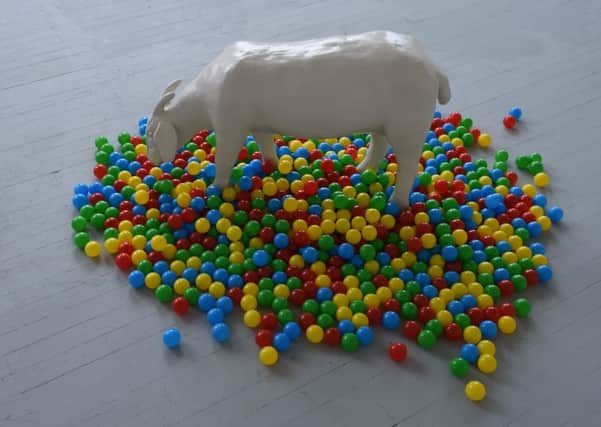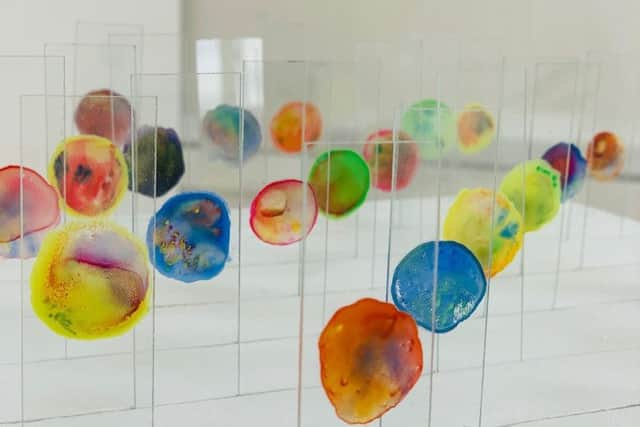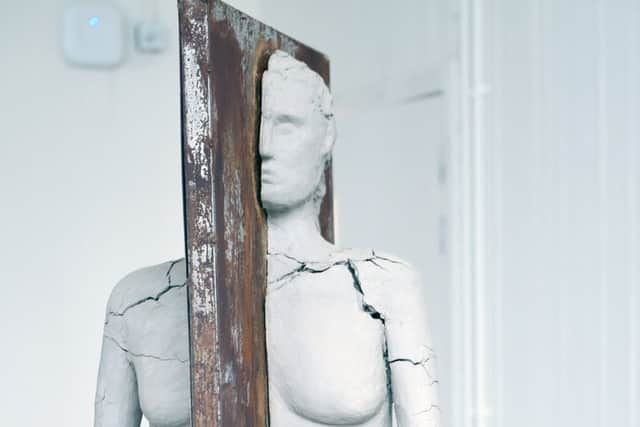Art review: Edinburgh College of Art Degree Show 2019


Edinburgh College of Art Degree Show 2019 ****
With the reopening of the whole building and especially its magnificent suites of studios, the students now have the luxury of space for their individual degree shows. And they certainly are individual. There is no common style or preoccupation, although it is notable that, as they still choose the discipline in which they specialise, the largest group by far are the painters, and many of them do actually paint, or draw or at least make things. One exception is a remarkable film by Alex Hayward. An exploration of gay love at a distance, its object is the remote figure of a ballet dancer on stage in Matthew Bourne’s Cinderella. It is a confessional and beautifully made. Even this is backed up with watercolours and drawings and this is largely true of other occasional electronic and installation works. Nor is Hayward alone in making his work very personal. Niamh Ferguson who comes from Belfast has focused on the physical legacy of the Troubles in photographs, but also in a very striking series of cast concrete models of watchtowers. It is more sculpture than painting, but very telling. Chell Young also works in three dimensions, making rather beautiful interiors with windows and doors. Lined with translucent paper, they are at once luminous and apparently spacious and reminiscent of Pieter de Hooch and other 17th century Dutch painters of interiors. Katerina Fletcher also makes images of interiors, but hers are dozens of intricate drawings of cut-away rooms containing bizarre but highly entertaining narrative scenes, all with humorous text commentary. A guinea pig-style cage for a pet human is just one example. She surely has a future in graphic novels.
Aidan Stephen’s personal journey has brought him to the College as a veteran of Afghanistan. A battered baggage label from his final return home is the only direct reference to whatever traumatic experiences he suffered. His beautiful small paintings of wide landscapes inspired by 70mm films, especially Westerns, and capturing in a small compass their space, light and colour, are tranquil enough, but pictures in a cabinet, tucked away in a cupboard, even hidden in a safe, all suggest the deeper currents that flow in all of us.


Advertisement
Hide AdAdvertisement
Hide AdBrandon Logan is also a painter, but he has managed to redirect painting towards the patterns and structures of the weavers of his native Orkney. His support is string stretched like the warp of a loom, but then he has painted on this and cut away the paint to create beautiful rhythmic patterns, suggesting incidentally the affinity between weaving and the binary structures of the computer. Heather Downie paints in patterns of small squares that also look rather binary at first, but which come to life as brilliantly coloured flat cut-outs. Annabel Stogdon is even more abstract using blue pigment, rather as Yves Klyne did, on standing panels to suggest with beautiful effect the gorgeous luminosity inherent in pure colour. She has also painted with light allowing the sun through a burning glass to trace its passage in blue wax. Daniel Purvis is also interested in blue pigment and light. His is the blue of cyanotype, the original blue-prints. He has created painted panels of blue which will gradually change in the light. Something that conservators want to prevent happening at all costs is here the point of the painting. Sculptor Gabrielle Gillott is also preoccupied with blue, a blue called “safe haven” which is recommended for “preppers” – people preparing dugouts or cellars for a no-deal Brexit, or worse. But she has gone all the way to create a subterranean safe haven entirely painted in sickly “safe-haven blue” and filled with blue painted empty tin cans. The prepper’s stock pile of baked beans has run out. Also a sculptor, Lauren Holehouse makes an emphatic point about Brexit with a trail of folded newspapers looping round one wall of the Mural Room and then carrying on downstairs, each with a different, but always awful Brexit headline.
Some of the most beautiful paintings are by Zuzana Ullmannová. On unprimed silky material, they seem so delicate that they too might be evanescent, but they have real quality. Rosalind Sanderson is a more forceful painter revisiting abstract expressionism to great effect. Rachel Sved paints a wild phantasmagoria of anarchic figures. Two grotesques have also emerged from the canvas to appear as pink gargoyles sticking out of the wall. Using fabric, rope and flat painted surfaces Intermedia student, Jane Mewis-Mckerrow, creates rather elegant “paintings” in thee dimensions.
The majority of the students this year are women and several want their gender to be manifest. Satirical pink is consequently the chosen colour of Gabriela Grant whose show is titled “These tits are mine.” It is a feminist manifesto, but also satirising both aspects of feminism and the attitudes that make it necessary. She is outspoken certainly, but also thoughtful. Becca Tarrant, or Reb T as she styles herself, is even more in your face. She only paints erect penises, though if you overlook the distracting motif, her paintings are rather good. I suppose inhibition is incompatible with the creative thinking that is the College’s raison d’être.
Anna Rocke is a painter who seems to have taken her cue initially from Van Gogh, but has also moved on to add other inspirations. Her pictures are small and intense: landscapes, interiors, a Bonnard bathroom scene, for instance. Throughout she creates strong rhythmic patterns of brushwork as Van Gogh did, but they are so pronounced they almost seem like reliefs. Relief is a feature of Mariia Drobot’s powerful figurative paintings too, as she creates highlights by cutting deeply into the wood of her support. Sculptor Tansy Burton uses found wood as her medium but then adds exquisitely recreated patterns of fungal and other parasitic growths. Emelia Kerr-Beale is a painter, but she too creates sculpture. A strange mythical creature dominates her show, but it also includes rather beautiful paintings and remarkable knotted rugs. Sculptor Hugo Harris’s wax figures deconstructing the posed model are very striking.


There is much else to admire here, but I must at least mention photography which, with half-a-dozen students, is the smallest
group. Jo McShane’s photos of Niagara, especially the curving green water as it tips over the rim of the Falls, is particularly striking.
It may be cross-fertilisation with other disciplines, but the presentation of his work and indeed of others seems much more lively this year. As ever, the whole show is full both of excitement and promise. - Duncan Macmillan
Until 9 June